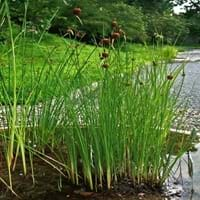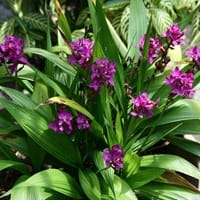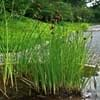Life Span
Perennial
Perennial
Type
Aquatics
Tender Perennial
Origin
Eastern Europe, Western Asia
Japan
Types
Common Cattail, Southern Cattail, Dwarf Bulrush
not available
Number of Varieties
Not Available
Habitat
Lake margins, Ponds, Swamps
Temperate Regions
USDA Hardiness Zone
3-11
7-9
Sunset Zone
21,22
H1, 7, 8, 9, 14, 15, 16, 17, 19, 20, 21, 22, 23, 24
Habit
Upright/Erect
Clump-Forming
Flower Color
Yellow, Green, Brown, Chocolate
White, Dark Red
Flower Color Modifier
Not Available
Bicolor
Fruit Color
Light brown, Light Red
Light Green, Tan
Leaf Color in Spring
Green, Dark Green
Light Green
Leaf Color in Summer
Green, Dark Green
Green, Light Green
Leaf Color in Fall
Green, Dark Green
Green, Light Green
Leaf Color in Winter
Brown
Light Green
Leaf Shape
Long linear and narrow
Long linear and narrow
Plant Season
Summer, Fall, Winter
Spring, Summer
Sunlight
Full Sun, Partial Sun
Partial Sun, Partial shade
Type of Soil
Clay, Loam, Sand
Loam, Sand
The pH of Soil
Acidic, Neutral
Acidic, Neutral
Soil Drainage
Poorly Drained
Well drained
Bloom Time
Summer, Late Summer, Early Fall
Spring, Late Spring, Early Summer
Tolerances
Wet Site
Drought
Where to Plant?
Container, In Water
Ground
How to Plant?
Runners
From bulbs
Plant Maintenance
Low
Medium
Watering Requirements
Plant grows in water
Requires regular watering
In Summer
Aquatic Plant
Lots of watering
In Spring
Aquatic Plant
Moderate
In Winter
Aquatic Plant
Average Water
Soil pH
Acidic, Neutral
Acidic, Neutral
Soil Type
Clay, Loam, Sand
Loam, Sand
Soil Drainage Capacity
Poorly Drained
Well drained
Sun Exposure
Full Sun, Partial Sun
Partial Sun, Partial shade
Pruning
Prune in early spring, Remove damaged leaves, Remove dead branches, Remove dead leaves
cut main flower spike, Prune after flowering, Remove damaged leaves, Remove dead branches, Remove dead leaves
Fertilizers
Nitrogen, Phosphate
All-Purpose Liquid Fertilizer, Compost
Pests and Diseases
Red blotch
Crown rot
Plant Tolerance
Drought
Drought
Flower Petal Number
Single
Single
Foliage Texture
Medium
Coarse
Foliage Sheen
Matte
Matte
Attracts
Birds, Flying insects
Butterflies, Hummingbirds, pollinators
Allergy
no allergic reactions
Unknown
Aesthetic Uses
Beautification, Showy Purposes, Water gardening
along a porch, deck or patio, Bonsai, Bouquets, Showy Purposes
Beauty Benefits
Not Available
Not Available
Environmental Uses
Food for animals, Food for birds, Food for insects, Nesting sites for birds
Air purification
Medicinal Uses
Nutrients
No Medicinal Use
Part of Plant Used
Leaves
Not Available
Other Uses
Decoration Purposes, Showy Purposes, Used as Ornamental plant
Cut Flowers, Decoration Purposes
Used As Indoor Plant
Yes
No
Used As Outdoor Plant
Yes
Yes
Garden Design
Bog Garden, Container, Water Gardens
Container, Feature Plant, Groundcover, Mixed Border, Rock Garden / Wall, Wildflower
Botanical Name
TYPHA minima
CALANTHE discolor
Common Name
Dwarf Cattail
Ground Orchid, Japanese Hardy Calanthe Orchid
In Hindi
बौना कैटेल
Ground Orchid
In German
Dwarf Rohrkolben
Ground Orchid
In French
Cattail nain
Ground Orchid
In Spanish
Espadaña enano
Ground Orchid
In Greek
Νάνος Cattail
Ground Orchid
In Portuguese
Tifa Dwarf
Ground Orchid
In Polish
Dwarf Ożypałka
Ground Orchid
In Latin
Pumilio Cattail
Ground Orchid
Phylum
Tracheophyta
Magnoliophyta
Class
Liliopsida
Liliopsida
Family
Typhaceae
Orchidaceae
Clade
Angiosperms, Commelinids, Monocots
Angiosperms, Monocots
Tribe
Not Available
Arethuseae
Subfamily
Not Available
Epidendroideae
Number of Species
Not Available
Properties of Dwarf Cattail and Ground Orchid
Wondering what are the properties of Dwarf Cattail and Ground Orchid? We provide you with everything About Dwarf Cattail and Ground Orchid. Dwarf Cattail doesn't have thorns and Ground Orchid doesn't have thorns. Also Dwarf Cattail does not have fragrant flowers. Dwarf Cattail has allergic reactions like no allergic reactions and Ground Orchid has allergic reactions like no allergic reactions. Compare all the properties and characteristics of these two plants. Find out which of these plant can be used as indoor plant. If you are interested to decorate your house and garden, find out aesthetic uses, compare them and select the plant which will beautify your surrounding. Along with beautification, try comparing medicinal and edible uses of Dwarf Cattail and Ground Orchid and you can choose the plant having best and most benefits.
Season and Care of Dwarf Cattail and Ground Orchid
Season and care of Dwarf Cattail and Ground Orchid is important to know. While considering everything about Dwarf Cattail and Ground Orchid Care, growing season is an essential factor. Dwarf Cattail season is Summer, Fall and Winter and Ground Orchid season is Summer, Fall and Winter. The type of soil for Dwarf Cattail is Clay, Loam, Sand and for Ground Orchid is Loam, Sand while the PH of soil for Dwarf Cattail is Acidic, Neutral and for Ground Orchid is Acidic, Neutral.
Dwarf Cattail and Ground Orchid Physical Information
Dwarf Cattail and Ground Orchid physical information is very important for comparison. Dwarf Cattail height is 30.50 cm and width 45.70 cm whereas Ground Orchid height is 25.40 cm and width 30.50 cm. The color specification of Dwarf Cattail and Ground Orchid are as follows:
Dwarf Cattail flower color: Yellow, Green, Brown and Chocolate
Dwarf Cattail leaf color: Green and Dark Green
Ground Orchid flower color: White and Dark Red
- Ground Orchid leaf color: Light Green
Care of Dwarf Cattail and Ground Orchid
Care of Dwarf Cattail and Ground Orchid include pruning, fertilizers, watering etc. Dwarf Cattail pruning is done Prune in early spring, Remove damaged leaves, Remove dead branches and Remove dead leaves and Ground Orchid pruning is done cut main flower spike, Prune after flowering, Remove damaged leaves, Remove dead branches and Remove dead leaves. In summer Dwarf Cattail needs Aquatic Plant and in winter, it needs Aquatic Plant. Whereas, in summer Ground Orchid needs Lots of watering and in winter, it needs Average Water.





